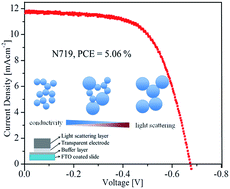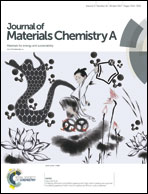Choosing the right nanoparticle size – designing novel ZnO electrode architectures for efficient dye-sensitized solar cells†
Abstract
A novel concept for constructing optimized ZnO-based photoanodes as integrative components of dye-sensitized solar cells (DSSCs) is realized by deploying differently sized nanoparticles, ranging from 2 to 10 nm, together with commercially available 20 nm nanoparticles. The 2 nm nanoparticles were used to construct an efficient buffer layer for transparent electrodes based on 10 nm nanoparticles, resulting in a relative increase of device efficiency from 1.8 to 3.0% for devices without and with a buffer layer, respectively. A mixture of 10 and 20 nm nanoparticles was optimized to maximize the diffuse reflection and to minimize the charge transport resistance in a light-scattering layer. This optimization resulted in a homogenous layer of more than 15 μm that provided a device efficiency of 3.3%. The buffer layer, transparent electrode, and light-scattering electrode, were then combined to give an overall efficiency of around 5%. Thus, this work demonstrates that varying the electrode architecture with nanoparticles of different diameters is a powerful strategy for improving the overall efficiency of ZnO-based DSSCs.



 Please wait while we load your content...
Please wait while we load your content...